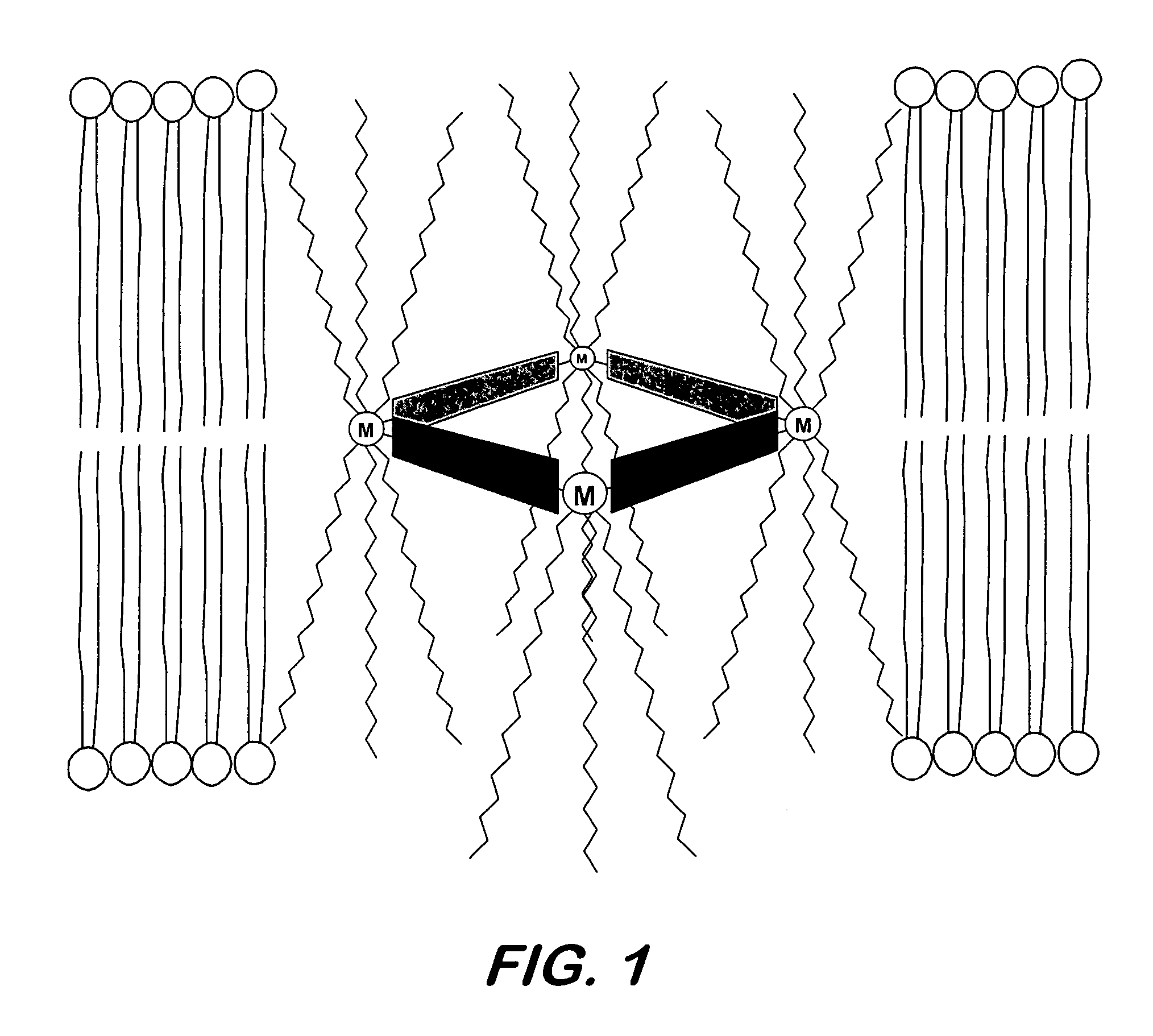Synthetic nanopores for DNA sequencing
a technology of dna sequencing and nanopores, applied in the field of cyclic oligomeric compounds, can solve the problems of increasing the noise level, fragile proteins, and inability to scale up for industrial production
- Summary
- Abstract
- Description
- Claims
- Application Information
AI Technical Summary
Benefits of technology
Problems solved by technology
Method used
Image
Examples
example 1
[0036]Synthesis of 1,4-bis(4-ethynylpyridine)benzene—This dipyridine spacer compound has been reported in the literature (Champness et al., “An Improved Preparation of 4-Ethynylpyridine and its Application to the Synthesis of Linear Bipyridyl Ligands,”Tetrahedron Lett., 40, 5413-6416 (1999)) and was prepared according to known literature procedures. 400 mg of 4-ethynylpyridine hydrochloride (2.87 mmol), 451 mg of 1,4-diiodobenzene (1.37 mmol), 20 mg of bis(triphenylphosphino)palladium(II)dichloride (0.028 mmol), and 7 mg of copper(I)bromide were suspended in 10-15 mL of triethylamine and heated to 60° C. for 1 hour while stirring vigorously. Then the mixture was heated further and kept at reflux temperature for 48 hours. Subsequently the triethylamine was removed by evaporation under reduced pressure. The residue was dissolved in dichloromethane (100-200 mL) and the resulting dark solution was washed with 100 mL of a saturated aqueous solution of dipotassium carbonate. The dichlorom...
example 2
[0038]Synthesis of 4,4′-bis(ethynyl-4-pyridine)biphenyl—This spacer was synthesised by the same procedure as applied in Example 1 using 4,4′-diiodobiphenyl instead of 1,4-diiodobenzene. Characterization: 1H NMR (300 MHz, DMSO-d6, 300K), δ (ppm): 8.62 (d broadened, J=6.0 Hz, 2H; Ha), 7.84 (d broadened, J=8.5 Hz, 2H; Hh), 7.71 (m broadened, J1=8.5 Hz, 2H; Hb), 7.53(m, J1=6.0 Hz, 2H; Hg); 13C{1H} NMR (75 MHz, CDCl3, 300K), δ (ppm): 150.6 (s, 4C; Ca), 141.6 (s small; Ci), 133.2 (s, 4C; Ch), 132.1 (s small; Cc), 127.9 (s, 4C; Cb), 126.3 (s, 4C; Cg), 122.4 (s small; Cf), 94.4 (s small; Cd), 88.5 (s small; Ce).
example 3
[0039]Synthesis of bis(trioctylphosphino)—platinum(II)bis(trifluoromethanesulphonate)—This compound was obtained by replacing the chloride ions of bis(trioctylphosphino) platinum-dichloride with trifluoromethylsulphonate ions (CF3SO3−, also known as ‘triflate’). 57 mg of bis(trioctylphosphino)platinum(II)dichloride (0.057 mmol) were dissolved in 10 mL of dichloromethane. 29.1 mg of silver(I)trifluoromethanesulphonate (0.113 mmol) were added and the solution was stirred for about 1 hour under exclusion of light. The white precipitate (silver(I)chloride) was filtered off and the solution was evaporated under reduced pressure. Yield: 68 mg (97%).
PUM
| Property | Measurement | Unit |
|---|---|---|
| diameter | aaaaa | aaaaa |
| size | aaaaa | aaaaa |
| height | aaaaa | aaaaa |
Abstract
Description
Claims
Application Information
 Login to View More
Login to View More - R&D
- Intellectual Property
- Life Sciences
- Materials
- Tech Scout
- Unparalleled Data Quality
- Higher Quality Content
- 60% Fewer Hallucinations
Browse by: Latest US Patents, China's latest patents, Technical Efficacy Thesaurus, Application Domain, Technology Topic, Popular Technical Reports.
© 2025 PatSnap. All rights reserved.Legal|Privacy policy|Modern Slavery Act Transparency Statement|Sitemap|About US| Contact US: help@patsnap.com



